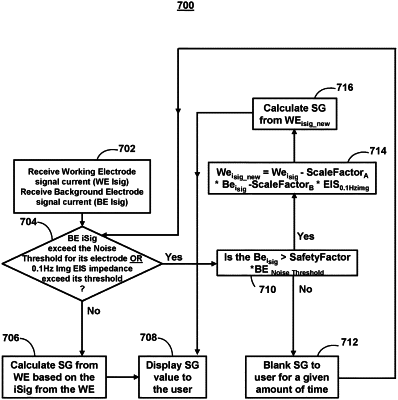| CPC A61B 5/14532 (2013.01) [A61B 5/1486 (2013.01); A61B 5/4848 (2013.01); A61B 5/7203 (2013.01); G16H 20/10 (2018.01)] | 9 Claims |

|
1. A system for continuous glucose monitoring, comprising:
one or more processors; and
one or more processor-readable media storing instructions which, when executed by the one or more processors, causes the system to:
activate a working electrode of a subcutaneously placed glucose sensor, the working electrode configured to generate a first sensor current;
activate a background electrode of the subcutaneously placed glucose sensor, the background electrode configured to generate a second sensor current;
cause a plurality of pulses to be applied to the working electrode and the background electrode to stabilize the glucose sensor;
set the working electrode to a first voltage potential, wherein the working electrode includes a glucose oxidase sensor and the first sensor current generated by the working electrode is affected by exposure of the glucose oxidase sensor to a medication ingested by a user;
set the background electrode to a second voltage potential greater than the first voltage potential, the background electrode having a metallization layer, wherein the second sensor current generated by the background electrode is not affected by exposure of the background electrode to the medication ingested by the user;
receive the first sensor current from the working electrode;
receive the second sensor current from the background electrode;
generate a sensor glucose value based on the first sensor current;
determine an electrochemical impedance spectroscopy (EIS) impedance value of the background electrode;
input the first sensor current and the second sensor current into a mathematical model that calculates a new value of the first sensor current based at least in part on the EIS impedance value of the background electrode; and
adjust the sensor glucose value based on the new value of the first sensor current calculated by the mathematical model.
|